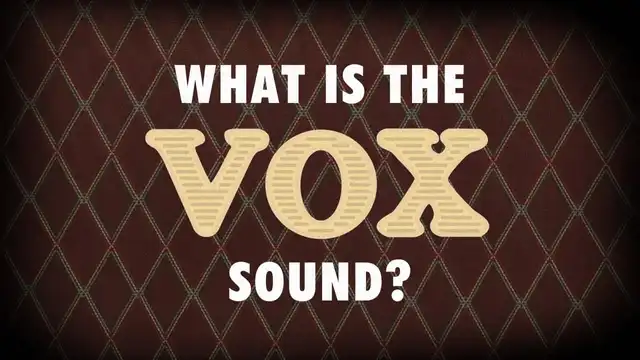What is the Vox Sound?


Ask any guitarist to list iconic amp brands and there’s a high probability that Vox will be in the top two. Used on countless classic records by beloved artists, the Vox sound has defined the way in which we hear and think about guitars. But, what is the Vox sound? Where did these amps come from and what was the intent behind their development? What sets them apart from other amps? And which artists drove public interest and established the basis by which we define the Vox sound? Let’s take a look and listen to see if we can’t put the Vox sound into words.
 Korg USA
Korg USA
I: The Vox Sound is Born
Vox’s story starts in the early 1950s when a Londoner named Thomas Jennings founded Jennings Organ Company, whose first success was the Univox keyboard.
The Organ Co.’s directed shifted in 1956 when a prototype guitar amp made by builder Dick Denney captured Jennings’ imagination. Jennings had previously taken a stab at designing a guitar amp without success. In 1957 he hired Denney as lead engineer and set about trying again.
Jennings and Denney divided their work on the amp, with Jennings taking lead on the physical design of the amp while Denney handled electronic components and schematics. Their division of labor led to the first Vox amp just one year later, with the release of the AC15 in 1958.
The Vox AC15
The AC15 was Vox’s first “real” amp, and it was an instant hit whose popularity endures to the present day for the way in which it established the classic, chimey, crunchy Vox sound.
Part of the beauty of the AC15 lies in its simplicity. It’s a 15 watt tube combo featuring two EL84 power tubes and a single 12” speaker. Fit with basic volume and tone controls, nothing about it screams “innovation.” The AC15 did come with a discrete “Vibravox” channel for vibrato. This circuit was borrowed from a Wurlitzer home console organ, and Vox was incredibly protective of its design.
The AC15 arrived just as British guitarists were shifting to electrics and needed an amp loud enough to compete with big bands, of which the AC15 was and is. One of the early adopters of the AC15 was The Shadows, an instrumental rock group that were popular in the late 50s. Reputable studio guitarist Vic Flick employed an AC15 in the studio and at live shows, and famously used one to record the legendary “James Bond Theme” for the Dr. No soundtrack, an incredibly enduring example of the Vox sound.
Flick and members of the Shadows had useful suggestions for Jennings and Denney that brought about the developments that led to Vox’s next classic amp.
The Vox AC30
The Shadows’ primary gripe with the AC15 was that it wasn’t quite loud enough to drown out large, rowdy audiences. Jennings frowned on the idea of a bigger amp, thinking it unnecessary, so Denney independently began work on a new design that would become the AC30.
Introduced later in 1958, the AC30 is essentially a beefed up AC15. It’s twice as powerful (30 watts) and contains two 12” speakers. This is exactly what The Shadows were looking for - a more powerful unit that maintained the Vox sound that was working so well for them.
In 1959, Vox released an upgraded version of the AC30 called the AC30 “Top Boost.” This amp featured a treble booster that, along with the AC30s added headroom, could produce clean sounds at very high volumes.
With the AC15 and AC30, British bands now had everything they needed for every type of gig, and Vox became a household name amongst English musicians. With rapid success under its belt, the Vox company was ready to keep growing, and the 1960s would bring a once-in-a-generation marketing opportunity via the greatest artist endorsement an amp company could dream of.
II: The Legend of the Vox Sound
As Vox gained traction in the early 1960s, they were approached by the manager of a relatively unknown and cash-strapped band in need of amps. After initially rejecting the request, Vox ultimately agreed to provide amps under the conditions that this band would exclusively play through Vox amps moving forward.
There were countless bands in the burgeoning British rock scene of the early 1960s. This one happened to be The Beatles, who from those early days until their breakup in 1970, used Vox amplifiers nearly all of the time, giving credence to the timeless quality of the Vox sound.
Another band called the Rolling Stones chose Vox amps, and the brand became a key part of the unstoppable force that was the British Invasion. Mick Jagger and Keith Richards even did an ad for Vox in 1965 with the tag: “VOX: Sound of the Longhairs.”
Along with the two biggest acts of the 60s, other legendary bands like the Yardbirds and the Kinks used Vox amps, stamping the Vox sound on dozens and dozens of records.
Vox was also churning out organs in the 60s. The Vox Continental hit the market in 1962 and appeared on countless iconic songs including the Animals’ “House of the Rising Sun” and “Light My Fire” by the Doors.
 The Beatles' backline.
The Beatles' backline.
What Makes Vox Special?
So, what is it about the Vox sound?
Vox offers incredible “all around” guitar amplifiers. From the AC15 to the AC100, Vox amps feature great cleans that can be pushed into crunchy, dirty territory with a dynamic response that inspires great performances. There is also the Vox “chime,” a marked brightness that never ranges into ice-picky harshness and instead retains focus and clarity. There are a lot of great amps out there, but none of them do quite what Vox amps do. That jangly, chime-y, clear, and treble focused sound is unique to Vox, and it’s a sound that inspired some of the most important musicians of the 20th century. The Beatles, the Stones, Queen, and on and on - if you can’t put your finger on it but you’ve listened to these artists, you’re already acquainted with the Vox sound.
III: The Vox Sound through Today
In 1967, Jennings left Vox, and the company suffered for losing its founder. Changes in ownership led to cost cuts,lower quality components, and a solid state line that strayed from the Vox’s original tube-driven ethos.
Vox lost a lot of the prestige it had generated, with even their staple amps becoming less appealing in the wake of lower quality offerings.
In the 90s Vox was purchased by Korg and its comeback was underway. Going back to its roots, Vox began producing high quality amps for professionals, and guitarists started coming back to the brand. Radiohead, U2, and other major bands of the 90s and aughts began using Vox amps that were voiced just like the original amps that defined the Vox sound.
Vox Amplifiers: an Enduring Icon
Beginning as an organ company, Vox became synonymous with electric guitars by producing some of the most important and popular amplifiers of all time. Used by some of the biggest acts in the world across multiple decades, a rough run in the 70s and 80s could not derail the iconic Vox sound. It’s something every guitarist should experience under their own fingers - so throw some Stringjoys on your axe, find yourself an AC30 to crank, and celebrate the chime that defined a generation.
Other Posts you may like

Guitar Strings Order: How the Guitar is Tuned and Why

Two Handed Tapping: Our Top 8 Tappers of All Time

Which Guitar Strings Wear Your Fret Wire Down More?

What is Nashville Tuning? Its History, Best Guitar Strings & Uses

Guitar Scale Length Explained: String Tension & Playability

What Guitar Strings I Used To Play...
0 Responses
Leave a Reply
Your email address will not be published. Required fields are marked *

